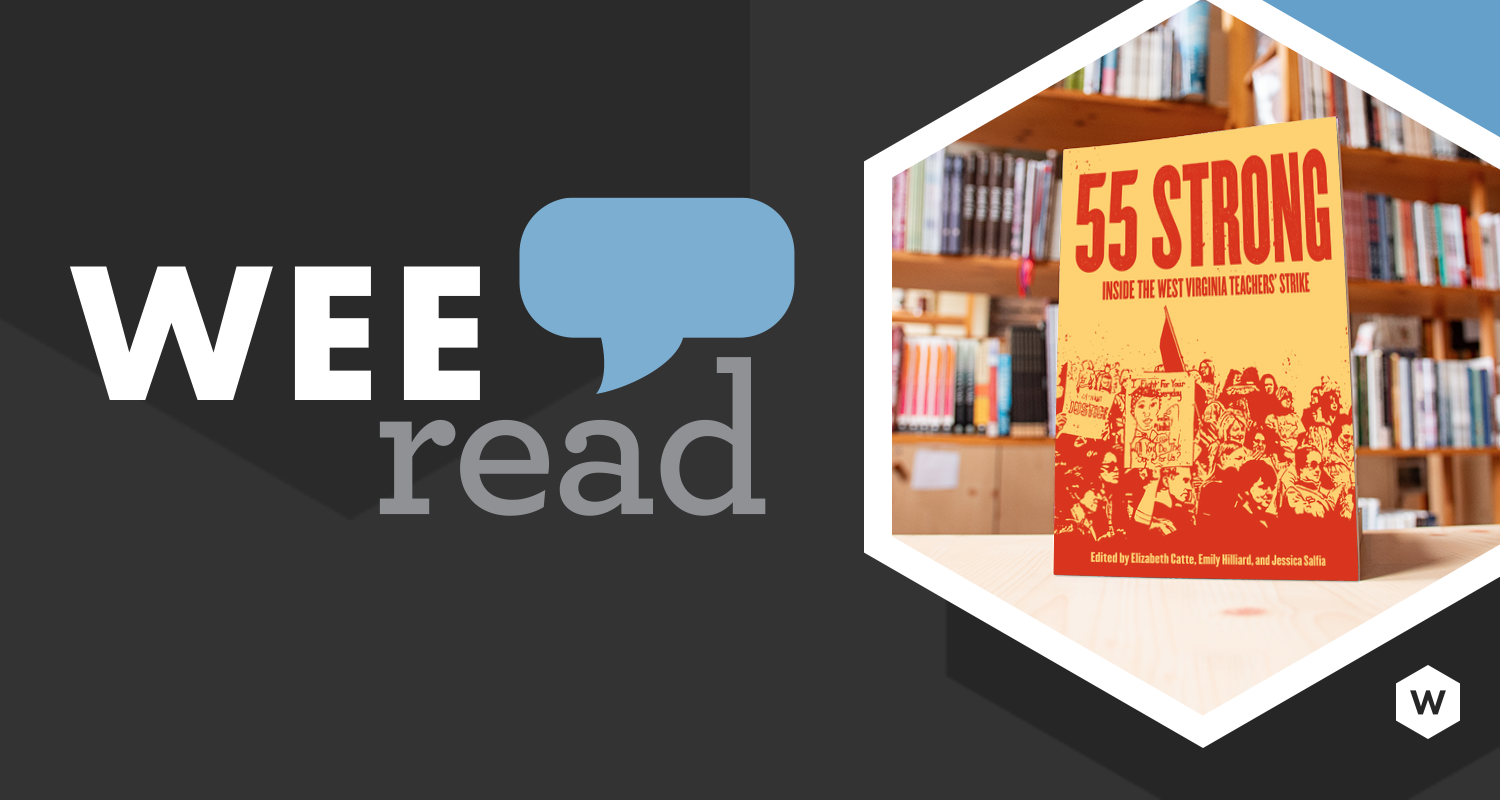With written testimonials and spontaneous on-the-street interviews, 55 Strong: Inside the West Virginia Teachers’ Strike is a deeply personal account of the circumstances that sparked the 2018 strike and its progress and aftermath. The collection is edited by historian and writer Elizabeth Catte, folklorist Emily Hilliard, and teacher and activist Jessica Salfia. Interspersed with impromptu interviews and photographs from the protest are essays from 14 teachers who participated in the strike and represent eight different West Virginia counties.
Spurred into action by rising insurance premiums and pay raises that would not keep up with the rising cost of living, teachers in Mingo and adjacent counties led a one-day walkout on February 2 for “Fed Up Friday.” The strike continued to gain a foothold throughout the state, and by February 22 all 55 counties were participating. It lasted for nine days and ended with a “wildcat” strike after teachers—against the recommendation of the unions—refused to accept Governor Jim Justice’s “good faith” offer. The strike continued until the House of Delegates approved a 5% raise for all teachers and state employees on March 6.
Though striking is illegal in the state of West Virginia, many of the teachers interviewed saw the decision to strike as a thoroughly West Virginian one, citing the strikes they watched their parents and grandparents participate in. Jessica Salfia recalls watching her own mother, also a teacher, participate in the West Virginia teachers’ strike of 1990. Others, like Katie Endicott, Brandon Wolford, and Emily Comer, see the willingness to stand on picket lines as, to quote Endicott, “part of our DNA; it is on our very blood.”
The testimonials from teachers compiled in 55 Strong serve as an example of the strength not only of West Virginia’s labor force but its women. Education is a female-dominated profession, with women making up approximately three-quarters of all educators in the United States. In an introduction by editor Jessica Salfia, she posits that part of the reason teachers are chronically underpaid and under-valued is because education is a female-dominated field. The gender divide became apparent to her during the protest at the State Capitol.
“The majority of teachers in America are women, and women were at the forefront of this movement. There was a clear gender divide between the red-clad folks chanting in the halls and the suit-clad folks sitting in the chambers…I believe that some of the stubbornness of the West Virginia Senate was because there were several men in those offices who didn’t like being told what they should be doing by a bunch of women.”
Though women make up the majority of the profession, they were not alone on the picket lines. Male teachers and administrators like Jay O’Neal, Brandon Wolford, and Daniel Summers and others participated in the strike and provided their testimonials. Participants also came from both sides of the political aisle, represented native and non-native West Virginians, and originated from varying socio-economic backgrounds. Despite differing backgrounds, they came together to be #55Strong, and it was their unity that ultimately made the strike a success.
Editor Salfia noted that, “This is the expectation for teachers. Do more with less. Be exceptional. Be a leader. Make sacrifices.” Teachers have continuously risen to the occasion and met this expectation. This is evident from the personal accounts in which teachers share how they have taken pay cuts and turned down better-paying jobs out-of-state to continue to serve the state and people they love. Everyone knows a teacher who gives selflessly because the vocation, by and large, attracts givers, carers, and doers. This collection exemplifies the power of an underpaid and often unsung profession.
In a moving essay by Karla Hilliard, she recounts meeting with her AP Literature students during the strike. Unable to “bring the kids to their education,” she opts to “bring the education to the kids” by reading Hamlet with them in a Panera Bread. Like editor Salfia, the strike led Hilliard to consider what it means to be a teacher and the job’s many expectations. Though it is evident Hilliard loves her job and her students, it is also clear that she and her fellow educators are expected to go above and beyond every day for their students—and even take a bullet for them. She observed that the teachers’ strike came just one week after the school shooting in Parkland, Florida that claimed the lives of 14 students and three staff members; all three staff members were killed while trying to protect students from the gunman.
As noted by contributor Daniel Summers, “This is a story that many Americans can relate to. Teachers do not have a monopoly on being underpaid and unjustly insured.” It is at times uplifting, other times sobering, and always a rallying cry. The West Virginia strike spurred teachers across the nation to do the same, leading to a wave of shutdowns, walkouts, and picket lines. Though unfortunate that the strike was necessary to secure West Virginia teachers a competitive wage, it is nevertheless a testament to the state’s strength and commitment to labor rights that its strike served as a catalyst that the nation followed.
Published by Belt Publishing, a free copy of the book can be requested by West Virginia school teachers and, for those looking to buy the book wholesale, ten percent of proceeds will be donated to a West Virginia teacher project. At 121 pages 55 Strong can be (and likely will be) read in one sitting. The collection is peppered with boldly colored pull-quotes, brief interviews, and photographs taken by editor Emily Hilliard during the strike. An inside look at a momentous part of West Virginia’s continued labor movement, 55 Strong would be a welcome addition to any bookshelf.
• Raised in Wellsburg, West Virginia, Anna Cipoletti is a proud alumna of Mount de Chantal Visitation Academy, West Liberty University and Kent State University. She received a Bachelor of Arts in English Literature from West Liberty in 2014 and a Master of Library and Information Science degree from Kent State in 2017. Anna has made a career out of a lifelong love of books and works full-time at Bethany College as a librarian and parttime as a bookseller and book reviewer. She resides in Beech Bottom with her sister and two Siamese cats. A nature enthusiast, Anna often spends her free time visiting one of West Virginia’s many beautiful parks or kayaking along Buffalo Creek.



